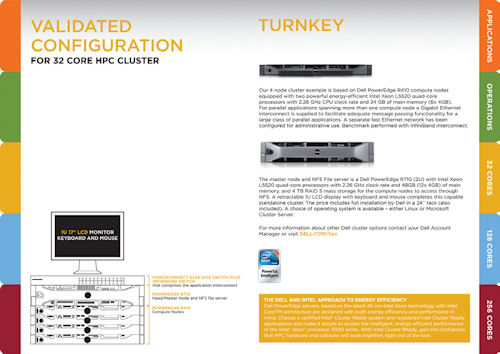
IT-free HPC Appliances
Pre-configured clusters try to take the high-performance computing middle ground.
Latest News
March 1, 2014
By Kenneth Wong
Late last year, when DE ran a survey on high-performance computing (HPC) adoption on behalf of IBM Platform Computing, participants cited a lack of budget (47%) and a lack of skilled IT personnel to manage the cluster (31%) as the top two barriers. The phenomenon prompted some software vendors and hardware partners to deliver a packaged solution: HPC in a box, preconfigured for simulation.
The specialized appliances target workgroups primarily, but they could also be a way to deal with peak demands in enterprises. Self-contained and portable, they can be managed independently from the company network. Some rest under a desk, with no need to be housed in a temperature-controlled server room.
Because the goal of the hardware is to reduce reliance on IT, many of these appliances come preloaded with simulation and job management software. They’re an attractive option for simulation-dependent businesses that don’t want to invest in full-scale data centers, but aren’t prepared to work exclusively with Software-as-a-Service (SaaS) either. For those caught in the tug of war between in-house servers and the cloud, plug-and-play simulation hardware might just be their safe harbor.
Revival after a Faltered Start
In 2010, ANSYS, Dezineforce, Dell and Microsoft came together to create what was described as a “turnkey HPC simulation appliance.” The idea was to deliver a mini-HPC server from Dell—preloaded with simulation software from ANSYS and management tools from Dezineforce and Microsoft. Then in early 2012, with little or no warning, Dezineforce closed up shop and disappeared. The ANSYS HPC appliance faded away.
But Wim Slagter, ANSYS’ lead product manager, has revealed that the appliance is about to come back.
“We’re targeting midsized companies that still rely on workstations, while HPC clusters would enable them to significantly decrease their time to solution,” he adds. “We revived the HPC appliance initiative with IBM in the middle of last year, but I should say it’s right now at a very early stage.”
In January, Lenovo, which purchased IBM’s PC business in 2004, announced its intent to acquire IBM’s x86 server business. The nature of the ANSYS-IBM HPC offerings may change after the acquisition. Barbara Hutchings, ANSYS’ director of strategic partnership, notes, “When the Lenovo-IBM transection is completed, ANSYS looks forward to continuing the HPC appliance offerings with the new business entity as its partner.”
Part of the HPC value proposition is to empower engineers to run more simulation, more often. But that proposition makes sense only if the software licensing policy allows users to take advantage of the added computing power. Current simulation software licensing models often draw ire from users—partly because of their complexity and partly because the cost increases significantly when users deploy the software on more powerful hardware (that is, running the software on more processing cores).
“With the HPC appliance, we also introduced HPC licensing to make [entry-level HPC clusters] more attractive,” says Slagter. The new licensing, he adds, “rewards volume HPC processing for entry-level 32- and 64-core clusters within a single workgroup sharing the same location.”
The clusters ANSYS offers in partnership with IBM tend to be larger, comprising hundreds of cores. ANSYS is considering other original equipment manufacturers like BOXX Technologies and Dell, which market smaller clusters. They remove IT dependency because “they need no special cooling, no special outlet, and they’re designed to be on desktop environments,” Slagter says.
A Box with Unlimited Runs
Last September, Altair, widely known for its HyperWorks engineering software suite, unveiled what it described as a “private cloud” solution. Developed in partnership with hardware maker SGI, HyperWorks Unlimited is supplied as rented hardware. It’s designed “to run pre- and post-processors ‘out of the box’ within the customer’s own location, and is completely managed and supported by Altair,” the company announced.
The “Unlimited” in its name refers to “unlimited use of all Altair software, including HyperWorks applications and PBS Works workload management tools,” according to Altair. Ravi Kunju, VP of strategy and business development at Altair, notes that many of the smaller clients don’t have the IT expertise to manage HPC, “especially Linux clusters. And even if they can find the experts, they’re expensive.”
So what does “out-of-the-box” mean? Kunju explains: “In the case of the first customer, within one hour after we rolled the appliance into their data center and uncrated it, they were running a large-scale simulation job on it.”
 An ANSYS brochure, detailing a 32-core turnkey cluster. |
Kunju says he’d seen both interest and adoption of the appliance among Altair customers, but prefers to keep the statistics private. He also revealed an insight into the purchasing behavior he’d witnessed. “In companies, there’s the software renewal cycle, and the hardware refresh cycle,” he reports. “In most cases, if we propose the appliance [to the buyer] when these two cycles coincide, we get a higher rate of success.”
One Foot in Sea, One on Shore
Not every simulation software vendor is jumping into the HPC appliance business, however. “We’re in the business of supplying world-class software, and we’re not in the business of selling hardware,” says David Vaughn, CD-adapco’s VP of worldwide marketing. “We have partners who have a lot more experience building hardware, and we work very closely with them.”
Vaughn adds he believes it’s more important to offer “flexible licensing options for the private cloud.”
For ANSYS, though, the HPC hardware and the cloud are not mutually exclusive. While it is reviving its HPC appliance initiative, ANSYS is also inking partnerships for pay-per-usage models from companies like Sweden’s Gridcore, France’s Bull, and U.S. firms such as Rescale, R-Systems and Penguin Computing. The two-pronged approach lets ANSYS customers maintain mini-HPC clusters for in-house use, but also turn to PaaS vendors when they need additional computing power.
In addition to the HyperWorks Unlimited Appliance, Altair offers the HyperWorks On-Demand program, where users may buy additional compute power to address peak workload. According to Altair, in its pay-per-usage model, “customers purchase a pool of HyperWorks Units (HWUs), which are used to gain access to the extensive suite of Altair’s software and HyperWorks Partners’ products ... allowing the same HWUs to access the HPC infrastructure in the cloud.”
For established businesses with predictable, consistent workloads, in-house data centers and HPC servers seem to offer the best bang for the buck. But for small- and mid-sized businesses, a mix of smaller HPC hardware and pay-as-you-go solutions may be the better alternative, as the dual approach gives them access to in-house HPC with low IT overhead, and on-demand computer power to address unexpected workloads.
Kenneth Wong is Desktop Engineering’s resident blogger and senior editor. Email him at [email protected] or share your thoughts on this article at deskeng.com/facebook.
More Info
Subscribe to our FREE magazine, FREE email newsletters or both!
Latest News
About the Author
Kenneth Wong is Digital Engineering’s resident blogger and senior editor. Email him at [email protected] or share your thoughts on this article at digitaleng.news/facebook.
Follow DE





